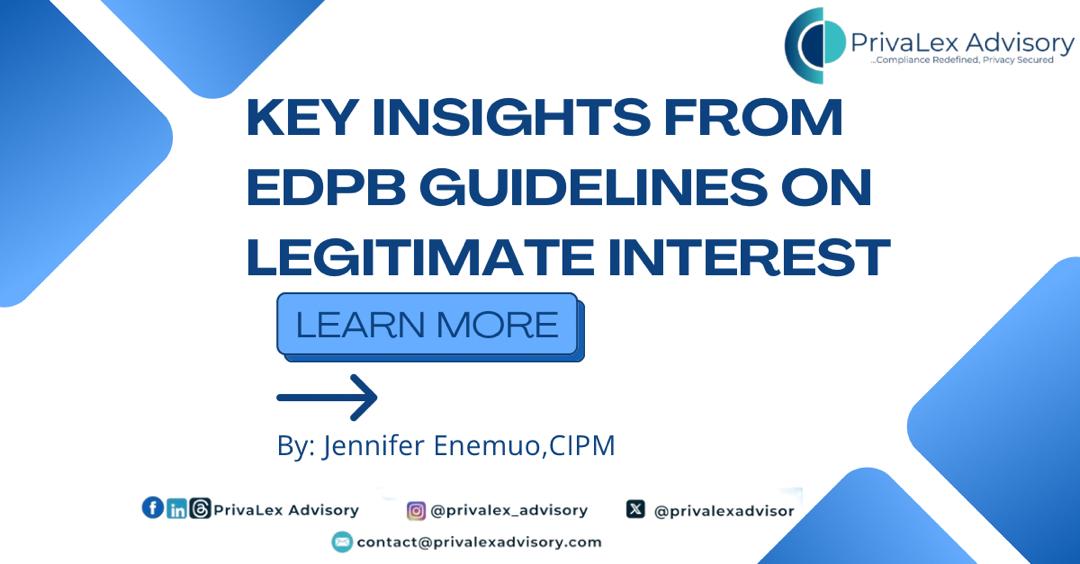Key Insights from EDPB Guidelines on Legitimate Interest

Key Insights from EDPB Guidelines on Legitimate Interest
The European Data Protection Board (EDPB) is an independent body with a juridical personality whose purpose is to ensure consistent application of the General Data Protection Regulation (GDPR). The EDPB’s provision of this guidance is to enable all controllers to understand and accurately assess how they can utilise this lawful basis, in compliance with the law. It will serve as a standard for all GDPR compliance with regards to Legitimate Interest.
Understanding Legitimate Interest
Legitimate Interests is one of the six lawful basis a data controller may rely on for the processing of personal data. For a processing to be legitimate, it must meet these three requirements:
To further understand the term legitimate interest, it is important to distinguish between “interest” and “purpose”
A “purpose” is the specific reason why the data is processed: the aim or intention of the data processing. An “interest”, on the other hand, is the broader stake or benefit that a controller or third party may have in engaging in a specific processing activity.
An interest may be regarded as “legitimate” if the following cumulative criteria are met:
When Can Personal Data Be Shared for Third-Party Interests?
Instances where personal data may be processed in the interest of a third party include:
What Does ‘Necessity’ Mean in the Context of Data Processing?
For a processing to be deemed “necessary”, you must ascertain in practice that the legitimate data processing interests pursued, cannot reasonably be achieved in an effective manner that reduces the restriction of the fundamental rights and freedoms of data subjects.
If there are reasonable, just as effective, but less intrusive alternatives, the processing may not be considered to be “necessary”. The court of Justice of the European Union (CJEU) mandated that all such processing must be examined in conjunction with the “data minimisation” principle in Article 5(1)(c) of the GDPR.
NB: it is generally easier for a controller to demonstrate the necessity of the processing to pursue its own legitimate interests than to pursue the interests of a third party. Also, the latter kind of processing is generally less expected by the data subjects.
How Do We Balance Data Subject Rights Against Legitimate Interests?
The last condition to be met to rely on Article 6(1)(f) GDPR as a legal basis is that the legitimate interest in question must not be overridden by the interests or fundamental rights and freedoms of the data subject.
To properly analyse the rights of data subjects alongside the interests pursued by the controller, the controller must identify and describe the following:
The data subjects’ interests, fundamental rights and freedoms. The impact of the processing on data subjects, including The nature of the data to be processed, The context of the processing, and Any further consequences of the processing. The reasonable expectations of the data subject. The final balancing of opposing rights and interests, including the possibility of further mitigating measures.
The purpose of the balancing exercise is not to avoid any impact on the interests and rights of the data subjects altogether. Rather, its purpose is to avoid a disproportionate impact and to assess the weight of these aspects in relation to each other.
Data Subjects Rights, Interests, and Freedom.
The explicit reference to “interests or fundamental rights and freedoms” in Article 6(1)(f) GDPR has a direct impact on the balancing test to be carried out under that provision. It provides more protection for the data subject, as it requires the data subjects’ “interests” to be taken into account, not only their fundamental rights and freedoms.
Some of the fundamental Rights and Freedom of data subjects include:
The interests of the data subjects to be taken into account as part of the balancing test include any interest that may be affected by the processing at stake, this includes but not limited to:
It is also important to pay attention to the nature of the data to be processed, things such as special category data enjoy additional protection under article 9 of the GDPR. And personal data relating to criminal convictions and offenses enjoy additional protection under Article 10 GDPR. Other factors to consider include any further consequences of processing and adverse outcomes that can be foreseen, and the reasonable expectations of the data subject.
Finalising the Balancing Test
At the end of this assessment, if the outcome is that the legitimate interest(s) being pursued are not overridden by the data subject’s interests, rights and freedoms, the envisaged processing may take place.
However, if the data subject’s interests, rights and freedoms seem to override the legitimate interest(s) being pursued, the controller may consider introducing mitigating measures to limit the impact of the processing on data subjects, in view of achieving a fair balance between the rights, freedoms and interests involved.
What’s Next for GDPR Guidelines After Public Consultation?
The Guidance itself is subject to public consultation until 20 November 2024. Following the consultation process, the EDPB will issue a final version of the Guidance, which will become the formal interpretation of this key lawful ground by all data protection regulators represented by the EDPB. This document provides an insight of what is to come if and when the set guidelines are approved.
